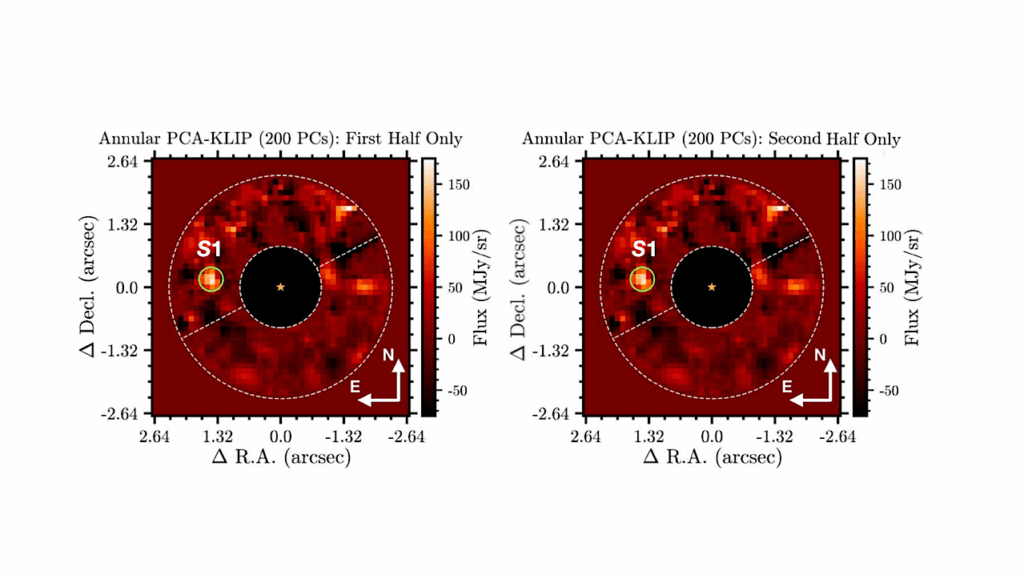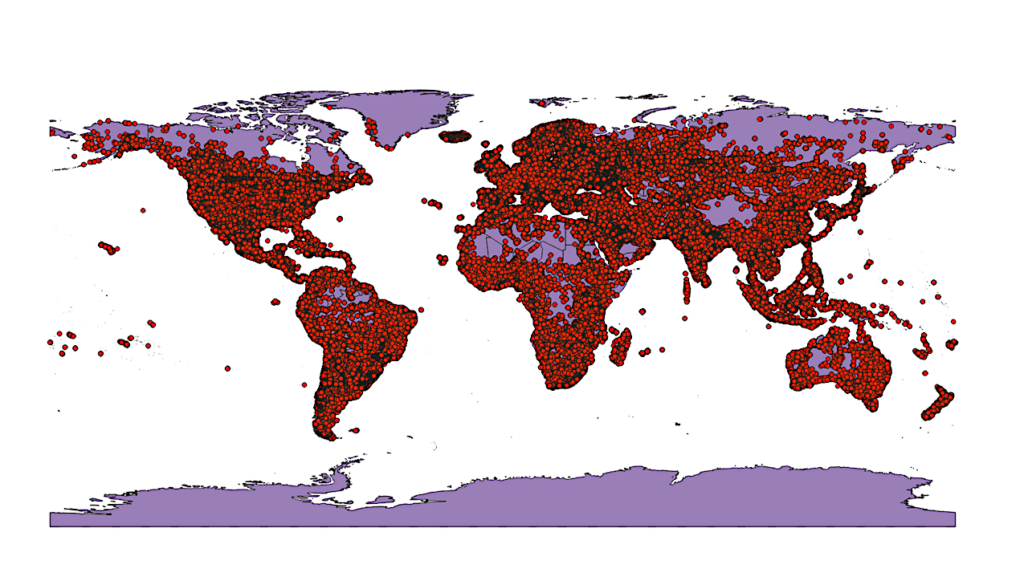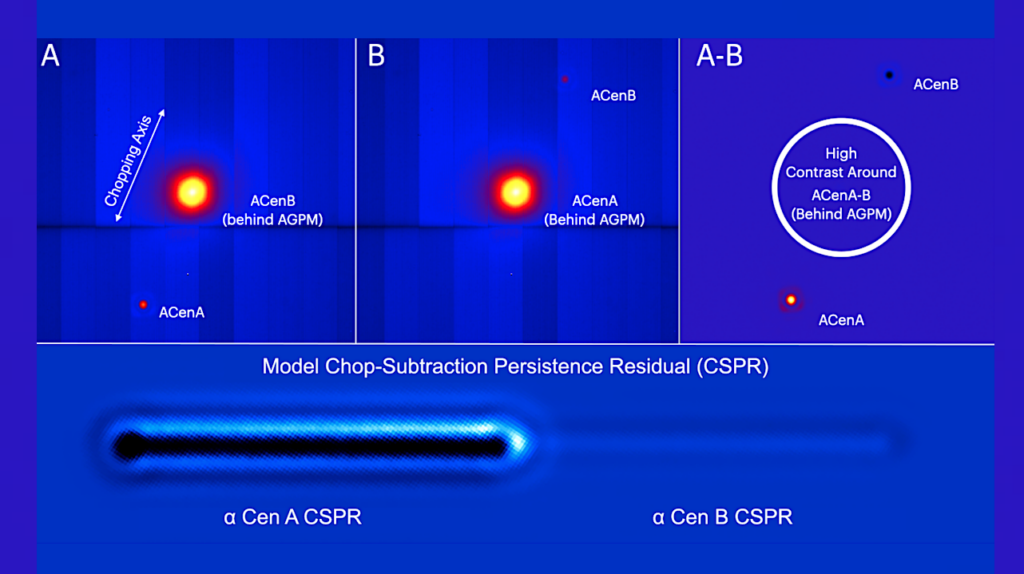Breakthrough Watch Enables Nearby Habitable-zone Exoplanets to be Directly Imaged

Breakthrough Watch, the global astronomical program looking for Earth-like planets around nearby stars, today announced a new observing technique with unprecedented sensitivity to directly image exoplanets. Their initial observations also resulted in the detection of a weak signal in the habitable zone of Alpha Centauri A, part of the star system nearest to Earth.
The technological achievements and the discussion of possible origins of this weak signal are presented today by the global team of astronomers in the journal Nature Communications in an article titled, “Imaging low-mass planets within the habitable zone of Alpha Centauri.” Data obtained from 100 hours of observation by the NEAR (New-Earths in the AlphaCen Region) program, at the ESO’s Very Large Telescope at the Paranal Observatory in Chile, open up the possibility of the detection of a candidate exoplanet in Alpha Centauri A’s habitable zone. While the team emphasizes that other explanations are possible for the faint signal, an intriguing possibility is that they’ve observed a planet roughly five to seven times the size of Earth orbiting within the habitable zone of the nearest sun-like star.
“We were amazed to find a signal in our data. While the detection meets every criteria for what a planet would look like, alternative explanations – such as dust orbiting within in the habitable zone or simply an instrumental artifact of unknown origin- have to be ruled out,” said the study’s lead author, Kevin Wagner, a Sagan Fellow in NASA’s Hubble Fellowship Program at the University of Arizona. “Verification might take some time and will require the involvement and ingenuity of the larger scientific community.”
The findings result from the evolution of ever more powerful and sensitive imaging technologies (an order of magnitude more sensitive to temperate planets than earlier exoplanet imaging approaches) and demonstrate the feasibility of imaging rocky, habitable-zone exoplanets with radii smaller than Neptune. The achievement was made possible through a cooperation among leading international space organizations, universities and the private sector initiative, Breakthrough Watch. Further analysis is underway to investigate the candidate planet. If it turns out to be a bona fide planet orbiting in the habitable zone of Alpha Centauri, that would have significant implications for the future of space exploration.
Alpha Centauri is the closest star system to ours, at 4.37 light years (about 25 trillion miles) away. It consists of two Sun-like stars, Alpha Centauri A and B, plus the red dwarf star, Proxima Centauri. Current knowledge of Alpha Centauri’s planetary systems is sparse. In 2016, a team using ESO instruments discovered one such possibly rocky planet orbiting Proxima Centauri. But potential Alpha Centauri A and B planetary systems have remained unknown quantities, until now.
The ESO’s Very Large Telescope, at eight meters in aperture, is among the world’s largest. In 2019 – with support from the Breakthrough Watch initiative – it was outfitted with new instrumentation that has allowed scientists, for the first time, to detect sub-Neptune sized exoplanets in the habitable zones of nearby stars, heralding a significant advance in observational capabilities.
Imaging potentially habitable exoplanets has presented a major technical challenge, since the starlight that reflects off them from their host stars is generally billions of times dimmer than the light coming to us directly from those stars. Resolving a small planet close to its star at a distance of several light years has been compared to spotting a moth circling a streetlamp dozens of miles away. To solve this problem, in 2016 Breakthrough Watch and ESO launched a collaboration to build a thermal infrared coronagraph, designed to block out most of the light coming from the star and optimized to capture the infrared light emitted by the warm surface of an orbiting planet.
In addition to helping drastically reduce the light of the target star and thereby reveal the signatures of potential terrestrial exoplanets, the coronagraph modifies existing instrumentation to optimize its sensitivity to infrared wavelengths, enabling it to detect potential heat signatures similar to that emitted by the Earth.
Building upon these advances, an ambitious $3 million observation program led by Breakthrough Watch and ESO – called NEAR (New Earths in the AlphaCen Region) –conducted more than 100 hours of observation beginning in 2019, to hunt for exoplanets within the habitable zones of the two Sun-like stars. It was developed in collaboration with the Univ. of Uppsala in Sweden, the University of Liège in Belgium, CEA – Université Paris-Saclay, the California Institute of Technology in the US, and Kampf Telescope Optics in Munich, Germany.
In addition to advancing coronagraph technologies, the NEAR experiment further developed technologies for adaptive optics to strategically deform the telescope’s secondary mirror, compensating for the distortion produced by the Earth’s atmosphere. It has also employed novel chopping strategies that reduce noise by allowing the instrument to switch rapidly between target stars — as fast as every 50 milliseconds -and thus maximize the available telescope time.
Beginning on May 21, 2019, ESO’s astronomers at ESO’s Very Large Telescope (VLT) conducted 100 hours of observation to establish the presence or absence of planets within Alpha Centauri’s habitable zones. Habitable-zone planets as small as about three times the size of Earth became detectable with the upgraded instrumentation. Rocky planets have radii that are typically less than about 1.7 times that of Earth. NEAR has demonstrated that such worlds will likely soon be imaged at the rate of current progress.
“ESO is glad to have contributed its expertise, substantial infrastructure, and observing time on the Very Large Telescope to the NEAR project and looks forward in the years ahead to exploring other nearby star systems,” commented ESO project leader Markus Kasper.
“The new capability that we demonstrated with NEAR to directly image nearby habitable-zone planets is inspiring to further developments of exoplanet science and astrobiology,” says Kevin Wagner, University of Arizona.
Pete Worden, Executive Director of the Breakthrough Initiatives, said: “Only a few years ago, we set out on a search for possible Earth-like planets circling Alpha Centauri A and B. We built the machinery that could do the job, and now a candidate planet has revealed itself. The power of concerted, global scientific collaboration is quite astonishing.”
“When we collaborate on a global scale, we discover new worlds, and we keep advancing,” said Yuri Milner, founder of the Breakthrough Initiatives. “The identification of a candidate habitable-zone planet in our celestial backyard will continue to power our curiosity.”
____________
Project Leadership
Dr. Markus Kasper – European Southern Observatory
Dr. Kevin Wagner — University of Arizona
Dr. Pete Klupar – Breakthrough Initiatives – Chief Engineer
Dr. Olivier Guyon – Chair, Breakthrough Watch Committee
Dr. Anna Boehle – Swiss Federal Institute of Technology (ETH), Zurich
Dr. Olivier Absil — University of Liège, Belgium
Dr. Eric Pantin – CEA, Paris
___________
Notes
All data from the NEAR campaign are publicly available at archive.eso.org under program ID 2102.C-5011(A). Original and processed data are also available from the authors upon request.
European Southern Observatory (ESO) is the foremost intergovernmental astronomy organization in Europe and the world’s most productive ground-based astr
onomical observatory and comprised of 16 Member States. ESO carries out an ambitious program focused on the design, construction and operation of powerful ground-based observing facilities. At Paranal, ESO operates the Very Large Telescope and its world-leading Very Large Telescope Interferometer as well as two survey telescopes, VISTA working in the infrared and the visible-light VLT Survey Telescope. ESO’s Very Large Telescope (VLT) has added to its suite of advanced instruments, with a newly modified instrument VISIR (VLT Imager and Spectrometer for mid-Infrared). On May 21, 2019, it made its first observations since being modified to aid in the search for potentially habitable planets in the Alpha Centauri system.
The Breakthrough Initiatives are a suite of scientific and technological programs, founded by Yuri Milner, investigating life in the Universe. Along with Breakthrough Watch, they include Breakthrough Listen, the largest ever astronomical search for signs of intelligent life beyond Earth; and Breakthrough Starshot, the first significant attempt to design and develop a space probe capable of reaching another star. https://breakthroughinitiatives.org
Breakthrough Watch, among the Breakthrough Initiatives portfolio, is global astronomical program to develop Earth- and space-based technologies that can identify and characterize planets around nearby stars (within 20 light years of Earth) that could harbor and support life, and ultimately find evidence of primitive life in our cosmic neighborhood. All these philanthropic initiatives are funded by the Breakthrough Foundation established by Yuri and Julia Milner. https://breakthroughinitiatives.org/initiative/4
Yuri Milner founded DST Global, a leading technology investment firm. Its portfolio has included some of the world’s most prominent internet companies, such as Facebook, Twitter, WhatsApp, Snapchat, Airbnb, Spotify, Alibaba, and others. He lives in Silicon Valley with his family. He graduated in 1985 with an advanced degree in theoretical physics and subsequently conducted research in quantum field theory. Yuri and his wife Julia have partnered with Sergey Brin, Priscilla Chan and Mark Zuckerberg, Pony Ma and Anne Wojcicki to fund the Breakthrough Prizes – the world’s largest scientific awards, honoring important, primarily recent, achievements in Fundamental Physics, Life Sciences and Mathematics. In July 2015, together with Stephen Hawking, Yuri launched the $100 million Breakthrough Listen initiative to reinvigorate the search for extraterrestrial intelligence in the Universe; and in April 2016 they launched Breakthrough Starshot – a $100 million research and engineering program seeking to develop a technology for interstellar travel.
Images Image Credit: Breakthrough Initiatives / ESO / Univ. of Arizona Collaboration
Astrobiology








